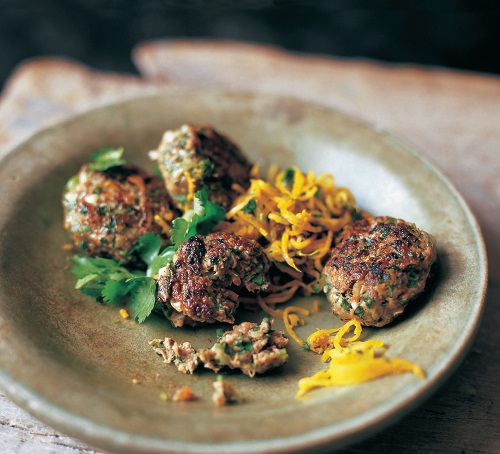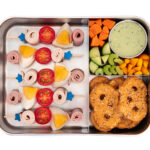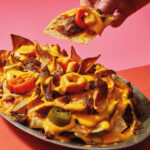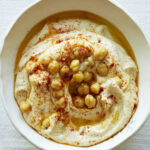For our second featured recipe from Jeffrey Alford and Naomi Duguid’s Beyond the Great Wall, we’re sharing their instructions for the tangy green-flecked lamb sausages they discovered in what they describe as a “meat marathon” at a tiny restaurant in the grasslands of inner Mongolia.
“Here is our version of the herbed lamb sausages I ate with pleasure out in the Hulun Buir grasslands, flavored with generous amounts of minced scallions, coriander leaves, ginger, and garlic. Lamb sausage casings can be hard to find, so we use pork casings. Make the sausages 24 hours before you wish to cook them, so they have time to dry a little and firm up.
To serve the sausages, cut into slices and present on a plate along with one or more condiments such as chutneys and chili pastes.
If you prefer not to make sausages, the mixture makes delicious lamb patties (pictured above) for grilling or frying. They are less traditional but much easier and quicker.”
Mongolian Lamb Sausages and Lamb Patties
- 1 pound boneless lean lamb shoulder or leg, well chilled, or 11⁄4 pounds ground lamb
- 1⁄4 pound (about 1⁄2 cup packed) coarsely chopped lamb fat (if not using ground lamb; see Note)
- 1 cup coarsely chopped garlic chives or 4 large garlic cloves, coarsely chopped
- 1 cup coarsely chopped scallions (white and tender green parts)
- 2 cups coriander leaves and stems
- 3 tablespoons minced ginger
- 11⁄2 teaspoons salt
- 1 teaspoon freshly ground black pepper (optional)
- About a 3-foot length of pork casings if making sausages
- Vegetable oil or peanut oil if panfrying
If using lamb shoulder or leg, cut the chilled meat into thin slices. Place the lamb fat in the food processor and process to a paste. Add the meat and process just until a springy pink ball forms. Turn out into a bowl and set aside. If using ground lamb, place in a bowl and set aside.
Place the garlic chives or garlic in the processor and pulse to finely chop, then add the scallions, coriander, and ginger and pulse to mince them. Alternatively, mince the garlic chives or garlic, scallions, coriander, and ginger by hand.
Add the flavorings to the meat, along with the salt and the pepper, if using, and use your fingers to blend the greens into the meat (we find this results in a better texture than mixing the two in the processor). Cover well with plastic wrap and refrigerate for 30 minutes.
TO MAKE SAUSAGES: Untangle the sausage casing and rinse well under cold water. Open one end with your fingers and place it under a gently running tap so that the water flows through the casing and rinses it. Squeeze the water out of the casing, and tie a simple knot in one end.
Unless you have a mechanical sausage maker, the easiest way of stuffing the sausages is to use a 2-quart plastic soda bottle. Cut it crosswise into two pieces, about 6 inches from the bottom. The top half is your new sausage-making tool.
Pick up the sausage casing and fit the open end over the top of the soda bottle, then slide it along the neck of the bottle as far as it will go (about 1 inch). With the top pointing away from you and the cut edge braced against your torso, use both hands to slide the rest of the sausage casing up onto the neck of the bottle; it may seem at first as if it won’t fit, but it will, and the work goes quickly. Once it’s all on except the knotted end, hold it firmly on the neck with the fingers of one hand.
Take the sausage mixture out of the refrigerator. With your free hand, scoop up a small handful of the mixture and place it inside the top of the bottle, then use your index finger to push it through the neck of the bottle into the casing. It’s easiest to fi ll the casing if you’re working very close to the bottle, so hold tightly to the casing and bottle top with the fingers of one hand to maintain tension as you stuff the casing, gradually releasing a little more of it until you have 4 inches of tightly stuffed casing. The stuffing is soft, so force it tightly into the casing; try to keep air out of the casing. Twist the casing to seal off the first sausage, twisting it 4 or 5 times to make a space before the next one. Continue to make sausages, maintaining tension and trying to fill each one full without air bubbles. Your hands will soon get comfortable, and you’ll be surprised at how quickly you reach the end of the length of casing. (Note: As you twist later sausages, make sure the earlier ones don’t come untwisted. If they do, twirl them again.)
Tie a knot to seal off the last sausage (like tying off a balloon) and lay the sausages on a plate in a loose coil. (If you have any filling left over, you can use it for patties to fry or grill; see below.) Cover loosely and refrigerate for 24 hours. The sausages will give off a little liquid, which you should pour off, and they’ll firm up.
You can fry the sausages in a little oil in a large heavy skillet over medium heat or grill them over a moderate flame. Prick them all over with a fork, toothpick, or fi ne skewer before cooking. Panfry or grill for about 10 minutes, turning them to expose all sides to the heat.
To serve, cut into long diagonal slices and set out on a plate, along with a condiment or two.
TO MAKE LAMB PATTIES: Scoop up a scant 3 tablespoons (a golfball-sized clump) of the chilled meat mixture and shape into a firm patty about 2H inches across and I to 1 inch thick. (This size is easy to handle in the pan or on the grill.) Set on a plate, and repeat with the remaining mixture, to make 16 patties.
Place a large heavy skillet over medium-high heat and add about 1 tablespoon oil. Add the patties in batches and panfry for about 4 minutes on each side to cook them through, less for a pinker interior; add a little more oil if necessary. Alternatively, prepare a medium-hot fire in a charcoal grill or preheat a gas grill. Grill the patties for about 4 minutes per side, or until done as you like. Serve with your choice of condiments.
Makes about 8 sausages, serving 4 to 6 as a main course with rice or potatoes or noodles, and a vegetable side dish, or 16 patties, serving 5 to 6 as part of a meal.
NOTE ON LAMB FAT: You can ask your butcher for lamb fat, or else trim it from roasts and chops. Store it in the freezer so you have it on hand.
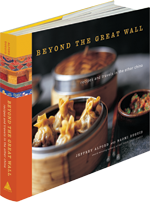
Beyond the Great Wall contains a rich mosaic of recipes, from Central Asian cumin-scented kebabs and flatbreads to Tibetan stews and Mongolian hot pots.
This month only, buy the ebook for just $2.99!
GET THE BOOK: Amazon | iBookstore | B&N | Kobo | Google | Sony

